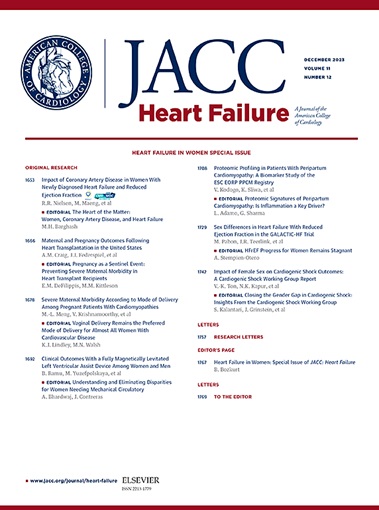新型可穿戴传感器对心衰再住院的影响:一项开放标签同时对照临床试验
IF 10.3
1区 医学
Q1 CARDIAC & CARDIOVASCULAR SYSTEMS
引用次数: 0
摘要
背景:早期发现心力衰竭失代偿的需求尚未得到满足:早期发现心力衰竭失代偿的需求尚未得到满足,因此需要对患者进行远程管理以避免住院治疗:本研究的目的是比较利用可穿戴式心衰传感器数据进行心衰住院后管理的策略与常规护理:符合条件的受试者在过去 10 天内出院,并在过去 6 个月内发生过高血压事件。同期对照研究分为两组:对照组(BMAD-HF)和开放标签干预组(BMAD-TX)。受试者佩戴 HFMS(心衰监测系统)长达 90 天。在 BMAD-HF 对照组中,设备数据对研究人员和受试者是保密的,但在 BMAD-TX 干预组中,设备数据是主动提供的。通过对首次心房颤动住院时间的卡普兰-梅耶分析,评估了使用 HFMS 进行心房颤动管理的影响:93个研究机构共招募了522名受试者。共有 245 名 BMAD-HF 受试者和 249 名 BMAD-TX 受试者符合意向治疗分析的条件。90天内,189名受试者共住院276次,其中82名受试者的108次住院被确定与心衰有关。与对照组受试者相比,使用HFMS数据指导心衰治疗的受试者在心衰住院后90天内的心衰住院率降低了38%(HR = 0.62; P = 0.03):结论:对于近期接受过心房颤动住院治疗的患者,使用心房颤动管理系统数据进行心房颤动管理的策略可将 90 天内心房颤动再次住院的相对风险降低 38%。(Microcor对非卧床失代偿性心力衰竭的益处[BMAD-TX;NCT04096040]和Microcor对非卧床失代偿性心力衰竭的益处[BMAD-HF;NCT03476187])。本文章由计算机程序翻译,如有差异,请以英文原文为准。
Impact of a Novel Wearable Sensor on Heart Failure Rehospitalization
Background
There is an unmet need for early detection of heart failure decompensation, allowing patients to be managed remotely and avoid hospitalization.
Objectives
The purpose of this study was to compare a strategy utilizing data from a wearable HF sensor for management following a HF hospitalization to usual care.
Methods
Eligible subjects were discharged from the hospital within the previous 10 days and had a HF event in the previous 6 months. The concurrent control study was divided into 2 arms; a control arm, BMAD-HF and an open-label intervention arm, BMAD-TX. The HFMS (Heart Failure Monitoring System) was worn by subjects for up to 90 days. Device data was blinded to investigators and subjects in the BMAD-HF control arm but provided proactively in the BMAD-TX intervention arm. The impact of HF management with the HFMS was evaluated by Kaplan-Meier analysis of time to first HF hospitalization.
Results
A total of 522 subjects were enrolled in the study at 93 sites. A total of 245 subjects in BMAD-HF and 249 in BMAD-TX were eligible for intention-to-treat analysis. There were 276 hospitalizations in 189 subjects at 90 days, of which 108 events were determined to be heart failure related in 82 subjects. The subjects in the arm managed using HFMS data to direct HF therapy had a 38% lower HF hospitalization rate during the 90 days following a HF hospitalization compared to subjects in the control arm (HR: 0.62; P = 0.03).
Conclusions
In patients with a recent HF hospitalization, a strategy of using HFMS data for HF management is associated with a 38% relative risk reduction in 90-day HF rehospitalization. (Benefits of Microcor in Ambulatory Decompensated Heart Failure [BMAD-TX]; NCT04096040; Benefits of Microcor in Ambulatory Decompensated Heart Failure [BMAD-HF]; NCT03476187)
求助全文
通过发布文献求助,成功后即可免费获取论文全文。
去求助
来源期刊

JACC. Heart failure
CARDIAC & CARDIOVASCULAR SYSTEMS-
CiteScore
21.20
自引率
2.30%
发文量
164
期刊介绍:
JACC: Heart Failure publishes crucial findings on the pathophysiology, diagnosis, treatment, and care of heart failure patients. The goal is to enhance understanding through timely scientific communication on disease, clinical trials, outcomes, and therapeutic advances. The Journal fosters interdisciplinary connections with neuroscience, pulmonary medicine, nephrology, electrophysiology, and surgery related to heart failure. It also covers articles on pharmacogenetics, biomarkers, and metabolomics.
 求助内容:
求助内容: 应助结果提醒方式:
应助结果提醒方式:


